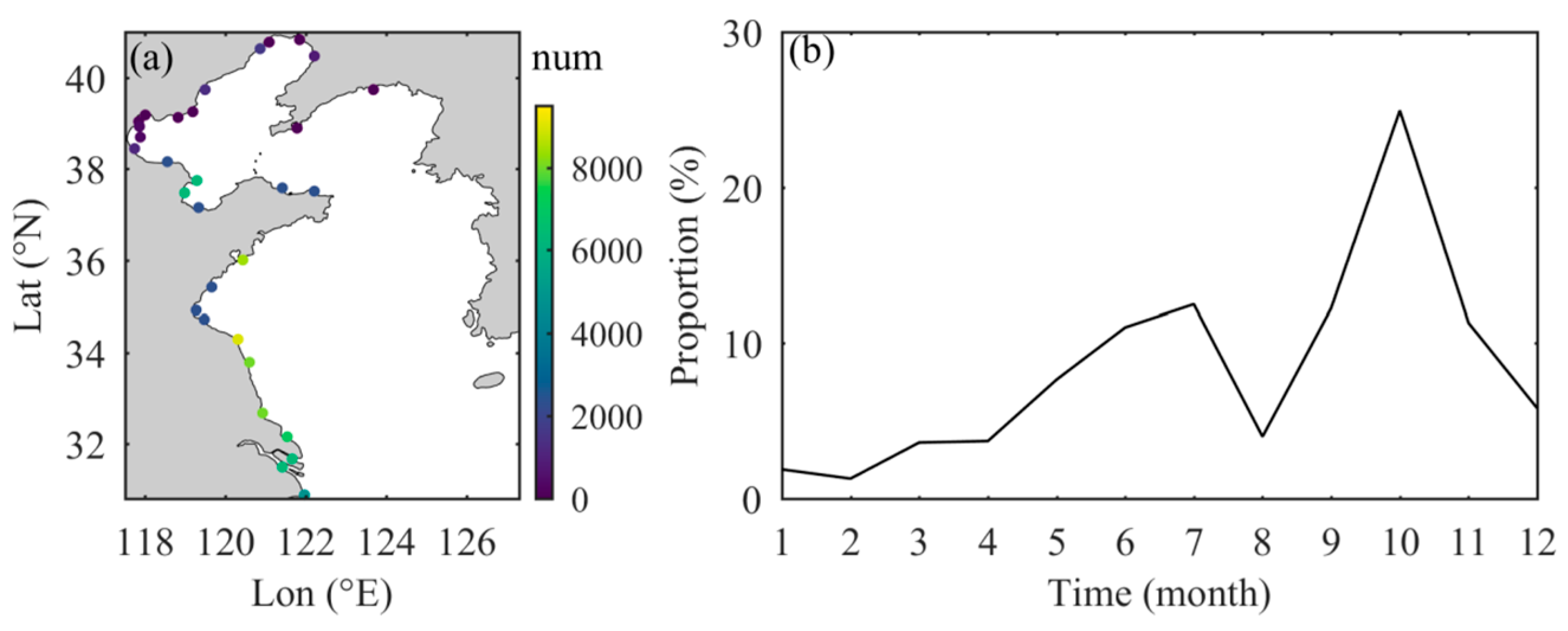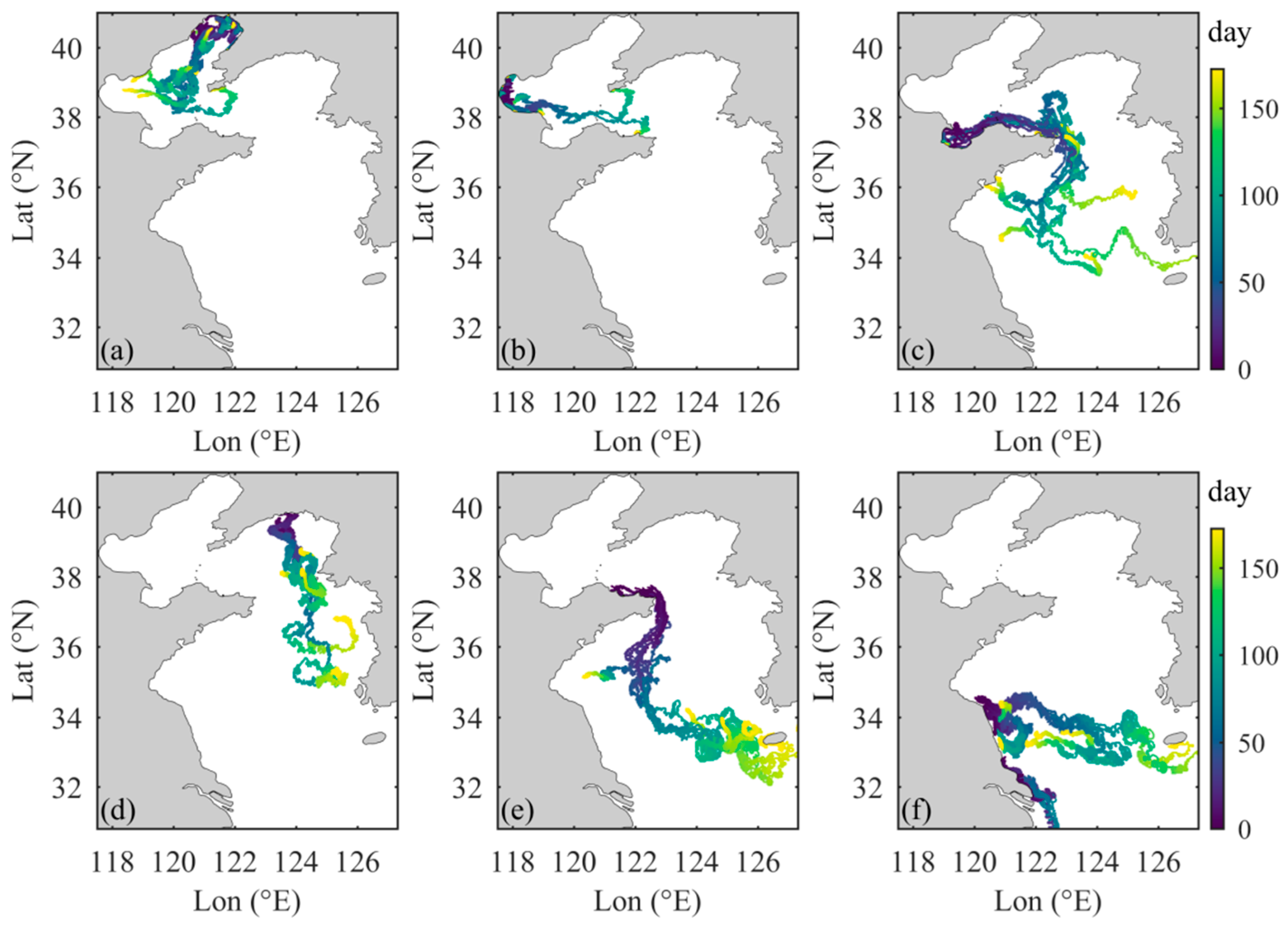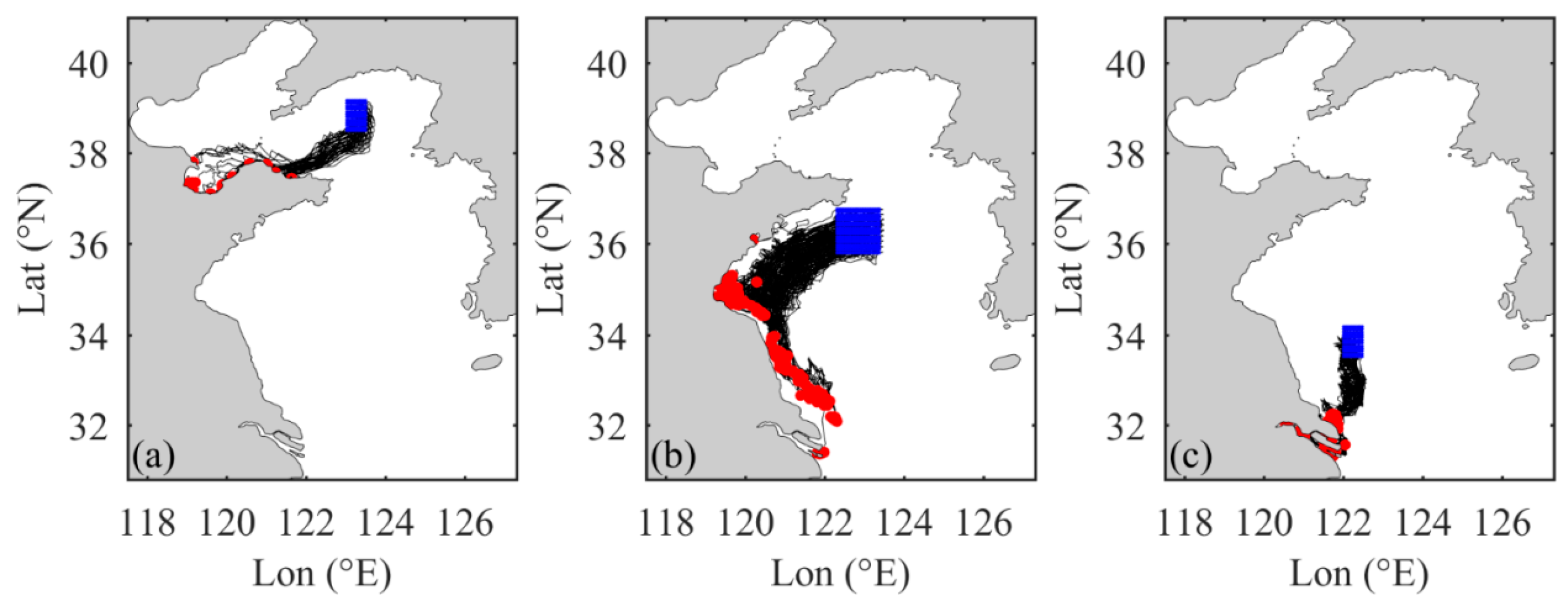Source-to-Sink Transport Processes of Floating Marine Macro-Litter in the Bohai Sea and Yellow Sea (BYS)
Abstract
1. Introduction
2. Materials and Methods
2.1. Field Observation of FMML
2.2. Numerical Model
2.2.1. Hydrodynamic Model
2.2.2. FMML Transport Model and Pathway Simulation
2.2.3. Model Configuration
2.3. Model Validation
2.4. Sensitivity of Settling Velocity in the FMML Transport Model
2.5. Backward Particle Tracking of FMML Hotspots in the BYS Formed During Summer
3. Results and Discussion
3.1. Seasonal Variation of FMML Distribution
3.2. FMML Transport from Different Sources
3.3. Source Tracking of FMML Hotspots in the BYS in Summer
4. Limitations and Recommendations
5. Conclusions
Supplementary Materials
Author Contributions
Funding
Data Availability Statement
Acknowledgments
Conflicts of Interest
References
- Gregory, M.R. Environmental implications of plastic debris in marine settings—Entanglement, ingestion, smothering, hangers-on, hitch-hiking and alien invasions. Philos. Trans. R. Soc. B Biol. Sci. 2009, 364, 2013–2025. [Google Scholar] [CrossRef]
- Praved, P.H.; Neethu, K.V.; Nandan, S.B.; Krishna, N.A.; Aneesh, B.P.; Sankar, N.D.; Antony, H.; Aravind, E.H. Multidimensional risk assessment of marine litter pollution in the ecologically fragile coral atolls of India. J. Environ. Manag. 2025, 376, 124578. [Google Scholar] [CrossRef] [PubMed]
- Galloway, T.S.; Cole, M.; Lewis, C. Interactions of microplastic debris throughout the marine ecosystem. Nat. Ecol. Evol. 2017, 1, 0116. [Google Scholar] [CrossRef]
- González-Fernández, D.; Cózar, A.; Hanke, G.; Viejo, J.; Morales-Caselles, C.; Bakiu, R.; Barceló, D.; Bessa, F.; Bruge, A.; Cabrera, M.; et al. Floating macrolitter leaked from Europe into the ocean. Nat. Sustain. 2021, 4, 474–483. [Google Scholar] [CrossRef]
- Lebreton, L.C.; van der Zwet, J.; Damsteeg, J.W.; Slat, B.; Andrady, A.; Reisser, J. River plastic emissions to the world’s oceans. Nat. Commun. 2017, 8, 15611. [Google Scholar] [CrossRef] [PubMed]
- Schmidt, C.; Krauth, T.; Wagner, S. Export of plastic debris by rivers into the sea. Environ. Sci. Technol. 2017, 51, 12246–12253. [Google Scholar] [CrossRef]
- Wilcox, C.; Van Sebille, E.; Hardesty, B.D. Threat of plastic pollution to seabirds is global, pervasive, and increasing. Proc. Natl. Acad. Sci. USA 2016, 113, 290–295. [Google Scholar] [CrossRef]
- Lebreton, L.; Slat, B.; Ferrari, F.; Sainte-Rose, B.; Aitken, J.; Marthouse, R.; Hajbane, S.; Cunsolo, S.; Schwarz, A.; Levivier, A.; et al. Evidence that the great pacific garbage patch is rapidly accumulating plastic. Sci. Rep. 2018, 8, 4666. [Google Scholar] [CrossRef]
- Law, K.L.; Morét-Ferguson, S.; Maximenko, N.A.; Proskurowski, G.; Peacock, E.E.; Hafner, J.; Reddy, C.M. Plastic accumulation in the North Atlantic subtropical gyre. Science 2010, 329, 1185–1188. [Google Scholar] [CrossRef]
- Phattananuruch, K.; Pokavanich, T. Monsoon-Driven dispersal of river-sourced floating marine debris in tropical semi-enclosed waters: A case study in the gulf of Thailand. J. Mar. Sci. Eng. 2024, 12, 2258. [Google Scholar] [CrossRef]
- Monchanin, C.; Desmolles, M.; Rivetta, K.; Saramul, S.; Charoenpong, C.; Mehrotra, R. Spatiotemporal variations in marine macro-litter pollution along the shoreline of Koh Mun Nai, an uninhabited island in the Gulf of Thailand. Environ. Pollut. 2024, 352, 124098. [Google Scholar] [CrossRef] [PubMed]
- Teng, G.; Shan, X.; Jin, X.; Yang, T. Marine litter on the seafloors of the Bohai Sea, Yellow Sea and northern East China Sea. Mar. Pollut. Bull. 2021, 169, 112516. [Google Scholar] [CrossRef]
- Teng, G.; Chen, W.; Shan, X.; Shi, Y.; Jin, X. Temporal and spatial distribution of floating marine macro litter in the offshore waters of the Bohai Sea and Yellow Sea (BYS). Mar. Pollut. Bull. 2024, 209, 117232. [Google Scholar] [CrossRef]
- Liao, Z.; Zou, Q.; Vinh, V.D.; Pan, Z.; Kaiser, M.J. Seasonal change in fate and transport of plastics from Red River to the coast of Vietnam. Mar. Pollut. Bull. 2024, 208, 116923. [Google Scholar] [CrossRef]
- Mansui, J.; Molcard, A.; Ourmieres, Y. Modelling the transport and accumulation of floating marine debris in the Mediterranean basin. Mar. Pollut. Bull. 2015, 91, 249–257. [Google Scholar] [CrossRef]
- Fleet, D.; Vlachogianni, T.; Hanke, G. A Joint List of Litter Categories for Marine Macrolitter Monitoring; EUR 30348 EN, JRC121708; Publications Office of the European Union: Luxembourg, 2021; ISBN 978-92-76-21445-8. [Google Scholar] [CrossRef]
- Vighi, M.; Ruiz-Orejón, L.F.; Hanke, G. Monitoring of Floating Marine Macro Litter—State of the Art and Literature Overview; EUR 31073 EN, JRC129261; Publications Office of the European Union: Luxembourg, 2022; ISBN 978-92-76-52436-6. [Google Scholar] [CrossRef]
- Chen, C.S.; Beardsley, R.C.; Cowles, G. An unstructured grid, finite-volume coastal ocean model (FVCOM) system. Oceanography 2006, 19, 78–89. [Google Scholar] [CrossRef]
- Weisberg, R.H.; Zheng, L. Circulation of Tampa Bay driven by buoyancy, tides, and winds, as simulated using a finite volume coastal ocean model. J. Geophys. Res. Oceans 2006, 111, C01005. [Google Scholar] [CrossRef]
- Ge, J.; Torres, R.; Chen, C.; Liu, J.; Xu, Y.; Bellerby, R.; Shen, F.; Bruggeman, J.; Ding, P. Influence of suspended sediment front on nutrients and phytoplankton dynamics off the Changjiang Estuary: A FVCOM-ERSEM coupled model experiment. J. Mar. Syst. 2020, 204, 103292. [Google Scholar] [CrossRef]
- Rutherford, K.; Bianucci, L.; Floyd, W. A simple approach to represent precipitation-derived freshwater fluxes into nearshore ocean models: An FVCOM4.1 case study of Quatsino Sound, British Columbia. Geosci. Model Dev. 2024, 17, 6083–6104. [Google Scholar] [CrossRef]
- Premathilake, L.; Khangaonkar, T.; West, J.; O’Neill, S.; Harding, L.; James, C.A.; Yun, S.; Bogue, K. Integrated modeling framework (FVCOM-ICM/Toxi) to simulate the fate and transport of polychlorinated biphenyls in urban estuaries—Case study for Puget Sound, WA. Ecol. Model. 2025, 500, 110959. [Google Scholar] [CrossRef]
- Zhong, Y.; Qiao, L.; Song, D.; Ding, Y.; Xu, J.; Xue, W.; Xue, C. Impact of cold water mass on suspended sediment transport in the South Yellow Sea. Mar. Geol. 2020, 428, 106244. [Google Scholar] [CrossRef]
- Zhong, Y.; Du, J.; Song, D.; Ding, Y.; Qiao, L.; Wang, Y.; Liu, X.; Yan, W.; Li, P.; Xu, G. Sediment dynamic responses to a severe typhoon in a stratified continental shelf sea. Ocean Model. 2025, 196, 102541. [Google Scholar] [CrossRef]
- Ministry of Ecology and Environment of China. China Marine Ecological Environment Quality Bulletin. Beijing, China. 2021. Available online: https://www.mee.gov.cn/hjzl/sthjzk/jagb/ (accessed on 27 May 2022).
- De Tender Caroline, A.; Annelies, H.; Sara, M.; Tom, R.; Peter, D. Bacterial community profiling of plastic litter in the Belgian part of the North Sea. Environ. Sci. Technol. 2015, 49, 9629–9638. [Google Scholar] [CrossRef]
- Chen, T. Formation of Biofilm on Microplastics and Its Influences on Physicochemical Properties of Microplastics in the Coastal Sea; University of Chinese Academy of Sciences: Bejing, China, 2018. [Google Scholar]
- Sun, Y.C.; Cao, L.; Wang, Y.T.; Chen, W.; Li, Y.; Zhao, X.Z. Sources and distribution of microplastics in the East China Sea under a three-dimensional numerical modelling. Environ. Pollut. 2022, 311, 119910. [Google Scholar] [CrossRef]
- Baudena, A.; Ser-Giacomi, E.; Jalón-Rojas, I.; Galgani, F.; Pedrotti, M.L. The streaming of plastic in the Mediterranean Sea. Nat. Commun. 2022, 13, 2981. [Google Scholar] [CrossRef]
- Baudena, A.; Kiko, R.; Jalón-Rojas, I.; Pedrotti, M.L. Low-density plastic debris dispersion beneath the Mediterranean Sea surface. Environ. Sci. Technol. 2023, 57, 7503–7515. [Google Scholar] [CrossRef] [PubMed]
- Pervez, R.; Lai, Z. Spatio-temporal variations of litter on Qingdao tourist beaches in China. Environ. Pollut. 2022, 303, 119060. [Google Scholar] [CrossRef] [PubMed]
- Bian, C.; Jiang, W.; Greatbatch, R.J. An exploratory model study of sediment transport sources and deposits in the Bohai Sea, Yellow Sea, and East China Sea. J. Geophys. Res. Oceans 2013, 118, 5908–5923. [Google Scholar] [CrossRef]
- Zhang, W.; Zhang, S.; Zhao, Q.; Qu, L.; Ma, D.; Wang, J. Spatio-temporal distribution of plastic and microplastic debris in the surface water of the Bohai Sea, China. Mar. Pollut. Bull. 2020, 158, 111343. [Google Scholar] [CrossRef]
- Zhang, M.; Lin, Y.; Booth, A.M.; Song, X.; Cui, Y.; Xia, B.; Gu, Z.; Li, Y.; Liu, F.; Cai, M. Fate, source and mass budget of sedimentary microplastics in the Bohai Sea and the Yellow Sea. Environ. Pollut. 2022, 294, 118640. [Google Scholar] [CrossRef]
- Qiao, S.; Shi, X.; Wang, G.; Zhou, L.; Hu, B.; Hu, L.; Yang, G.; Liu, Y.; Yao, Z.; Liu, S. Sediment accumulation and budget in the Bohai Sea, Yellow Sea and East China Sea. Mar. Geol. 2017, 390, 270–281. [Google Scholar] [CrossRef]
- Luo, C.; Lin, L.; Shi, J.; Liu, Z.; Cai, Z.; Guo, X.; Gao, H. Seasonal variations in the water residence time in the Bohai Sea using 3D hydrodynamic model study and the adjoint method. Ocean Dyn. 2021, 71, 157–173. [Google Scholar] [CrossRef]
- He, M.; Tian, F.; Zhai, X.; Zhou, K.; Zhang, L.; Guo, X.; Tang, Z.; Chen, H. Distribution and typologies of anthropogenic seafloor litter in the Pearl River Estuary and adjacent coastal waters, China. Mar. Pollut. Bull. 2024, 203, 116505. [Google Scholar] [CrossRef]
- Russo, T.; D’andrea, L.; Parisi, A.; Martinelli, M.; Belardinelli, A.; Boccoli, F.; Cignini, I.; Tordoni, M.; Cataudella, S. Assessing the fishing footprint using data integrated from different tracking devices: Issues and opportunities. Ecol. Indic. 2016, 69, 818–827. [Google Scholar] [CrossRef]
- Halpern, B.S.; Walbridge, S.; Selkoe, K.A.; Kappel, C.V.; Micheli, F.; d’Agrosa, C.; Bruno, J.F.; Casey, K.S.; Ebert, C.; Fox, H.E.; et al. A global map of human impact on marine ecosystems. Science 2008, 1979, 948–952. [Google Scholar] [CrossRef]
- Cau, A.; Sbrana, A.; Franceschini, S.; Fiorentino, F.; Follesa, M.C.; Galgani, F.; Garofalo, G.; Gerigny, O.; Profeta, A.; Rinelli, P.; et al. What, where, and when: Spatial-temporal distribution of macro-litter on the seafloor of the western and central Mediterranean sea. Environ. Pollut. 2024, 342, 123028. [Google Scholar] [CrossRef]
- Canals, M.; Pham, C.K.; Bergmann, M.; Gutow, L.; Hanke, G.; Van Sebille, E.; Angiolillo, M.; Buhl-Mortensen, L.; Cau, A.; Ioakeimidis, C.; et al. The quest for seafloor macrolitter: A critical review of background knowledge, current methods and future prospects. Environ. Res. Lett. 2021, 16, 023001. [Google Scholar] [CrossRef]
- Li, J.; Shan, E.; Zhao, J.; Teng, J.; Wang, Q. The factors influencing the vertical transport of microplastics in marine environment: A review. Sci. Total Environ. 2023, 870, 161893. [Google Scholar] [CrossRef]
- Amaral-Zettler, L.A.; Zettler, E.R.; Mincer, T.J. Ecology of the plastisphere. Nat. Rev. Microbiol. 2020, 18, 139–151. [Google Scholar] [CrossRef]
- Liro, M.; Zielonka, A.; van Emmerik, T.H.M. Macroplastic fragmentation in rivers. Environ. Int. 2023, 180, 108186. [Google Scholar] [CrossRef] [PubMed]
- Ji, C.; Zhang, J.; Liu, G.; Zhang, Q.; Shen, X. A settling velocity formula for irregular shaped microplastic fragments based on new shape factor: Influence of secondary motions. Sci. Total Environ. 2024, 955, 176857. [Google Scholar] [CrossRef]
- Fazey, F.M.C.; Ryan, P.G. Biofouling on buoyant marine plastics: An experimental study into the effect of size on surface longevity. Environ. Pollut. 2016, 210, 354–360. [Google Scholar] [CrossRef]
- Meng, D.Z.; Li, Y.Z. Assessing the settling velocity of biofilm-encrusted microplastics: Accounting for biofilms as an equivalent to surface roughness. Environ. Sci. Technol. 2024, 58, 1329–1337. [Google Scholar] [CrossRef] [PubMed]
- Critchell, K.; Lambrechts, J. Modelling accumulation of marine plastics in the coastal zone; what are the dominant physical processes? Estuar. Coast. Shelf Sci. 2016, 171, 111–122. [Google Scholar] [CrossRef]
- Shen, X.; Lin, M.; Chong, H.; Zhang, J.; Li, X.; Robins, P.; Bi, Q.; Zhu, Y.; Zhang, Y.; Chen, Q. Settling and rising velocities of microplastics: Laboratory experiments and lattice Boltzmann modeling. Environ. Pollut. 2024, 363, 125107. [Google Scholar] [CrossRef]
- Ji, C.; Zhang, J.; Liu, G.; Zhang, Q.; Xing, E. Towards better predicting the settling velocity of film-shaped microplastics based on experiment and simulation data. Mar. Pollut. Bull. 2024, 203, 116493. [Google Scholar] [CrossRef]
- Zhang, Z.; Wu, H.; Peng, G.; Xu, P.; Li, D. Coastal ocean dynamics reduce the export of microplastics to the open ocean. Sci. Total Environ. 2020, 713, 136634. [Google Scholar] [CrossRef] [PubMed]
- Turrell, W.R. How litter moves along a macrotidal mid-latitude coast exposed to a coastal current. Mar. Pollut. Bull. 2020, 160, 111600. [Google Scholar] [CrossRef]
- Chen, Z.; Bowen, M.; Li, G.Y.; Coco, G.; Hall, B. Retention and dispersion of buoyant plastic debris in a well-mixed estuary from drifter observations. Mar. Pollut. Bull. 2022, 180, 113793. [Google Scholar] [CrossRef] [PubMed]






Disclaimer/Publisher’s Note: The statements, opinions and data contained in all publications are solely those of the individual author(s) and contributor(s) and not of MDPI and/or the editor(s). MDPI and/or the editor(s) disclaim responsibility for any injury to people or property resulting from any ideas, methods, instructions or products referred to in the content. |
© 2025 by the authors. Licensee MDPI, Basel, Switzerland. This article is an open access article distributed under the terms and conditions of the Creative Commons Attribution (CC BY) license (https://creativecommons.org/licenses/by/4.0/).
Share and Cite
Teng, G.; Zhong, Y.; Shan, X.; Xi, X.; Jin, X. Source-to-Sink Transport Processes of Floating Marine Macro-Litter in the Bohai Sea and Yellow Sea (BYS). J. Mar. Sci. Eng. 2025, 13, 1887. https://doi.org/10.3390/jmse13101887
Teng G, Zhong Y, Shan X, Xi X, Jin X. Source-to-Sink Transport Processes of Floating Marine Macro-Litter in the Bohai Sea and Yellow Sea (BYS). Journal of Marine Science and Engineering. 2025; 13(10):1887. https://doi.org/10.3390/jmse13101887
Chicago/Turabian StyleTeng, Guangliang, Yi Zhong, Xiujuan Shan, Xiaoqing Xi, and Xianshi Jin. 2025. "Source-to-Sink Transport Processes of Floating Marine Macro-Litter in the Bohai Sea and Yellow Sea (BYS)" Journal of Marine Science and Engineering 13, no. 10: 1887. https://doi.org/10.3390/jmse13101887
APA StyleTeng, G., Zhong, Y., Shan, X., Xi, X., & Jin, X. (2025). Source-to-Sink Transport Processes of Floating Marine Macro-Litter in the Bohai Sea and Yellow Sea (BYS). Journal of Marine Science and Engineering, 13(10), 1887. https://doi.org/10.3390/jmse13101887





